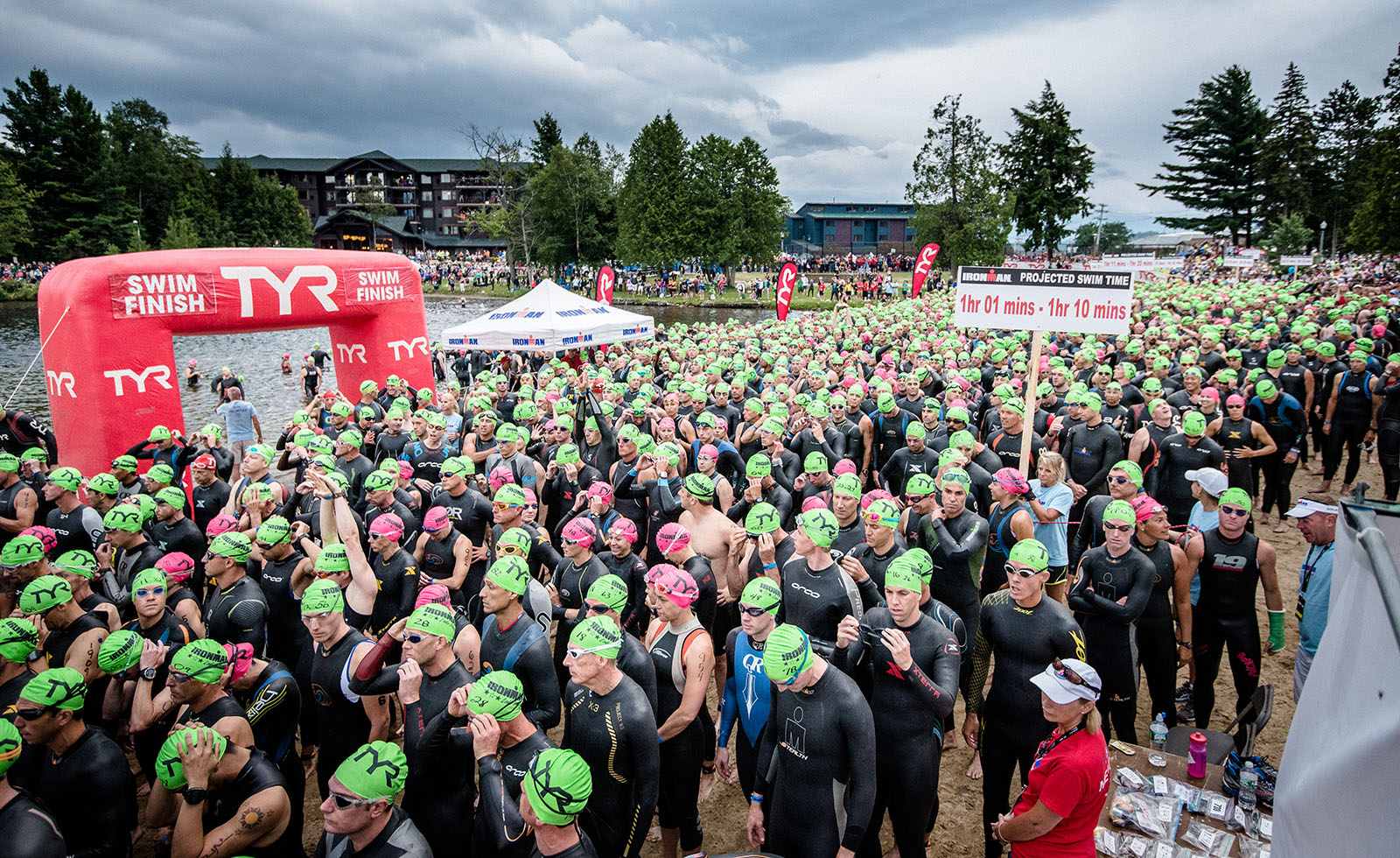This year’s Ironman adventure marks an interesting turn for our family – it’s the first time that Greg and I are racing the distance together, which means that after nearly 15 years of triathlon racing history, our parents will be unaccompanied spectators. And at an Ironman.
For triathletes, understanding how to spectate at this kind of venue is part intuition, part planning and, part luck. But for the sports’ unsung heroes – non-triathletes who clap, cheer, play coach and shrink, and yes, carry our gear – it is a bit harder. So, here’s my guidance for our first-time, unchaperoned spectators who will be joining us at Lake Placid for the 2014 adventure, all while watching our 2 young kids. Grandpa Frank, Oma and Nana, here goes. And for all the other spectators or Sherpas, this blog is for you, too.
1. Plan your spectating strategy in advance. A day or two before the race, sit down with your athlete(s), with a course map and identify the best spectating spots. Anchor on key intersections that are a few blocks beyond transition to give the spectators room to find “front row views”. Finding a spot beyond transitions gives your athlete a few seconds to gather him/herself before looking for their spectators (otherwise known as Sherpas, who will later carry the race gear.). Then, cross-reference your meeting points with your athlete’s expected pacing, so you know when you should plant yourself at the designated spots. Finally, if you’re able, actually locate those spots around town before race day, and make sure they work for both of you.
Don’t be scared to venture out of the main race hub. It’s more scenic and probably much more enjoyable. At IM Brazil, Greg hiked a miles or so out of town to find us on the run course – which was amazing because he pretty much was the only spectator at that part of the route. He had a lot of fans that day! And, at IM Wisconsin, they bused spectators out 10 miles to the start of bike course loop – right near an intersection of bars and restaurants – which created an electric environment (which was the closest someone like me will ever come to the Tour de France). Knowing my family would be somewhere nearby gave me something to look for, and a much needed lift on the course. Plus, they got to see some amazing scenery.
2. It’s exhausting; pace yourself. Here’s the dirty secret – it’s harder being a spectator than it is an athlete. I’ve been on both sides and I can truly say that standing on your feet for 6-10 hours, PLUS the emotional part of waiting for your athlete is exhausting. You can’t be everywhere. Nor should you be. So, make sure that you plan a day that works for your athlete and you. While they’re on the bike course, go for a swim or run. Have a leisurely breakfast and lunch. Do some shopping. Take in a movie. Whatever you do, give yourself the chance to take your mind off what your athlete is doing and think about you. The most important parts are the beginning and end. Make sure you’re there for those. The rest are “nice-to-have”.
3. Use the course tracking technology. They’ve made great strides in technology to let you know when athletes reach key milestones on the course. It will be incredibly helpful to let you know how much time you have the race to the next checkpoint, or give you emotional relief to know that you haven’t missed your athlete. IronmanLive.com is the site that allows you to track athletes’ progress, and this year we’re going to try out myathlete.com, which allows us to rent a small GPS device to provide pretty accurate tracking of us across the course. I’m not sure if it’s going to work in the Adirondacks, but we’re giving it a go.
4. Pack snacks & other sundries. Per my notes earlier, it’s a long day and wait times between athlete sightings can be pretty long, even with advances in technology. Pack a granola bar or sandwich, take an extra bottle of water. Make a pit stop for coffee. Often. Don’t forget the bug spray, sunscreen, chapstick and some extra cash for whatever you forgot to put in your bag. And, for the kids you have in tow, bring toys and diversions. You think you’re bored? They’re beyond un-entertained, and they get hungry quickly. I’ve packed spectating bags for the kids with sidewalk chalk, crayons and paper, books, and their own snacks so they feel like they’re having an adventure. Don’t be afraid to give them a cowbell too. The athletes will love you.
5. Make friends. Ironman is supercool in that everybody has a story – you have 2500+ athletes with their own sacrifices, motivators, demons and accomplishments. Beyond that, they all have supporters who also have made sacrifices to help get their athletes to the start line. Learn about your fellow spectators and their special people. Perhaps you’ll have a new appreciation for the extended Ironman family.
6. Take a nap. Few people are awake for 17 hours in a day, let alone spectating or racing an Ironman. If your athlete is likely to take the full time allotment, or is eager to head to the finish line for the midnight madness, you’ll need to rest in advance. The best times for naps are probably during the 2nd bike loop and the 1st loop of the run. Ideally, you’ve secured a hotel room that’s within walking distance of transition. Otherwise, curl up under a tree and set the alarm on your cell phone. Trust me, you’ll need the shut eye.
7. Take a valium (OK, this is a joke, but the point is valid). Very, very, very few people sustain major injuries at Ironman. It’s a tough day, but by the time athletes make it to the race start, they’ve trained for the event. Your athlete will be fine, and the volunteers and medical professionals will take excellent care of them along the way. This is what they do.
8. Cheer loudly – especially for people you don’t know. It’s really hard out there on the course, especially when you’re exhausted physically and mentally. Spectators, please cheer for everyone you see. Especially the athletes who look like they are struggling. On the run course, race numbers have athletes’ first names printed on them so you can direct your encouragement. Be loud. Be supportive. As the saying goes, “MORE COWBELL!” You can never have enough cowbell. Clever signs are awesome, too. I still have the big green “Go Mo” sign from my first two IMs in my garage. (Thanks, Nana!) And, marking the bike course with sidewalk chalk provides a much-needed mental lift during climbs, even for those of us whose names don’t appear. Be creative. Be encouraging. Be loud.
9. When you see your athlete, Lie. He or she will look terrible. Frankly, they will smell even worse. But you can’t say that. Honesty is not the best policy here. Cheer something like “you look awesome” or “hey, you look even better than the last time I saw you.” Or, “hey, you’re really gaining on your training partner – she is just ahead.” Be prepared to play shrink, especially on the run course. This is where IM is defined. Logic doesn’t apply. Your athlete will barely know how to spell his name at this point. Appeal to emotions. Whatever you chose to say, make it positive and clap while you say it. Look him in the eye, and if you need to do so, lie.
10. Allow your athlete to savor the moment. This is probably the single hardest part of the adventure. Once your athlete has finished, your inclination will be to pack up and go home. Your job is done. But, that’s not really the case. Your athlete trained for 9 – 12+ months for this. Allow him or her an hour or so to smile, eat, cheer on others and just bask in the accomplishment. Even though you’re exhausted, your athlete will get a second wind that is unfathomable to you. Someone who could barely walk a step during the race will want to jump up and down now. Give them the chance to enjoy themselves. And, don’t forget to offer to carry their bike for them. It’s what a Sherpa does.
11. Don’t cringe when they say “Yea, I’ll do another”. In my experience, the IM hangover typically lasts 12-48 hours. With luck, you’ll have them select another venue so you can check out another town next year. Better start planning!




